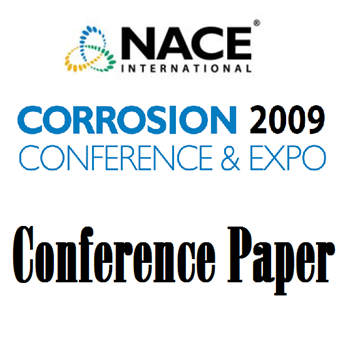Erosion-Corrosion of Low Carbon Steel Inhibition in Oil-Brine-Sand FlowAnass Nassef15 Michael W. Keller12 Dr. Kenneth P. Roberts13 Erin V. Iski13 Edmund F. Rybicki14 and Siamack A. Shirazi124 (379 words)In the oil and gas production industry carbon steel tubing and piping are susceptible to erosion-corrosion damage due to the erosive and corrosive nature of the flow. The combined effect of sand erosion and corrosion can increase the metal degradation rate while simultaneously decreasing the efficiency of corrosion protection systems including iron-carbonate scale formation and chemical inhibition. These combined effects can lead to higher corrosion rates surface pitting and material failure [1]. Accurate prediction of chemical inhibitor performance under sand production conditions is particularly significant when the wells are deep or off-shore because coupon testing is impractical and replacement costs are high. In the past the effects of erosion CO2 and chloride corrosion and erosion-corrosion had to be measured in separate tests. Repeating a test multiple times required extra time and introduced potential variation in system conditions from test to test. The study presented here is a continuation of research conducted in the Erosion/Corrosion Research Center at the University of Tulsa that using a recently developed flow loop that allows all three components to be measured simultaneously [2]. Measurements of corrosion erosion and erosion-corrosion were performed using linear polarization resistance (LPR) electrical resistance (ER) and weight loss (WL) measurement techniques. Experimental results from these tests are combined with phenomenological models in order to understand erosion-corrosion behavior in multi-phase erosive flows and to enable prediction capabilities for a variety of field conditions.Results from testing using the new 3-cell testing facility works will be discussed for oil-brine flows that contain both sand and chemical inhibitor. A phenomenological model based on Frumkin-type isotherm is presented as a technique for predicting inhibitor effectiveness for these complex flow conditions. Additionally experimental details regarding flow-loop modifications required to complete testing when using high oil concentrations and sand will be discussed.1. Erosion/Corrosion Research Center2. Mechanical Engineering Faculty3. Chemisty Faculty4. NACE Fellow5. Master of Science in Mechanical Engineering The University of Tulsa REFERENCES1.S. Hassani Erosion-Corrosion in CO2 Saturated Systems in Presence of Sand Inhibitor Oil and High Concentration of Salt PhD Thesis Department of Mechanical Engineering The University of Tulsa Tulsa OK.2." Corrosion Inhibition in Oil/Water Environments" M. Keller A. Hall A. Nassef K. Roberts S. Shirazi E. Iski E. Rybicki J. Shadley NACE International Annual Conference Dallas TX 2015.




